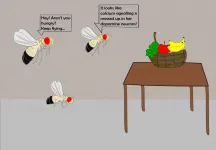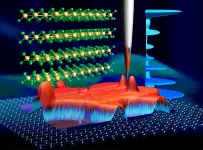(Press-News.org) 'A journey of a thousand miles begins with a single step' is a popular adage that talks about the initial thrust required to embark on a task. However, once begun, how do we persevere on the job and not let it fall apart like a New Year resolution? How do we stay motivated?
Well, these are not just philosophical deliberations, but compelling science projects for neuroscience aficionados. Scientists have in fact been on the lookout for the neuronal and molecular players which are at the root of governing motivation.
Here is a research story from the generous fruit fly that identifies the machinery behind the fly's relentless flying pursuits.
Prof. Gaiti Hasan's group, in a recent study, has discovered that the ability of flies to sustain flight for long periods of time is driven by a surge of calcium in select neurons of the brain that make the 'happy' chemical messenger, dopamine. At the forefront of this neuronal activity is an esteemed calcium channel protein called IP3 receptor (IP3R) which orchestrates the calcium gush in these dopaminergic neurons. Interestingly, they found that in addition to modulating the long flight voyages, the same troupe of neurons and molecules motivate hungry flies to actively seek food. The team hypothesises that having a single neuronal framework to modulate both these crucial behaviours could help the fly traverse longer distances in search of food.
"Flight is an innate behaviour of flies. Even though the neuronal circuit that pilots flight behaviour is hard-wired, we show here that it still needs to be fine-tuned by cellular calcium - especially calcium mobilized by the IP3R. Such modulation ensures that the fly's internal metabolic state and its response to external cues are balanced," explains Gaiti, whose lab has been working with the fly IP3R for several years now.
The IP3R is lodged within the cell's industrial highway - the endoplasmic reticulum. It translates extracellular messages into intracellular responses by opening the gates of calcium. These calcium spikes pivot neurons from silent to active states, which in turn drive behaviour.
In flies, the most striking behaviour regulated by the IP3R is maintenance of flight. This provided a nice window of opportunity to explore the biology behind sustaining flight - a motor behaviour that likely requires motivation. So, the researchers decided to track the cells that require IP3R function for flight and find out how they do it.
In pursuit of these answers, Anamika (graduate student and lead author) engineered a functionally frail version of the IP3 receptor (IP3RDN) which could override the activity of the normal copy (IP3R). When introduced into fly neurons, this genetic variant of the protein markedly dampened the calcium response. At the behavioural level, when IP3RDN was expressed in a just a few neurons of the fly brain, the flies faced a huge flight disadvantage; their flight times plummeted to just 1/3rd that of IP3RDN-free wild-type siblings.
What is the neuronal signature of these neurons?
Well, by tapping into an array of genetic tools available in flies, Anamika found that 2 pairs of dopamine producing neurons were controlling such sustained flight - that's just 4 neurons out of more than 25,000 neurons in the fly brain!
Having solved the 'where' part of the puzzle, the team went on to put together the 'how'. For this, Anamika used imaging techniques that use protein sensors to reflect neuronal activity. She noticed that by virtue of its central role in calcium signalling, the IP3R also holds the reins on neurotransmitter release - a trademark of neuron activation and communication.
But here is a nice turning point in the story.
"During the time we discovered the set of neurons that regulate flight through the IP3 receptor, a research study came out which showed that these same neurons are required for food-seeking behaviour in starved flies. But does IP3R in these neurons control food-seeking behaviour too?" asked Anamika.
To find out, she took flies expressing IP3RDN in the flight-regulating dopaminergic neurons and starved them for a few hours. Then, she let them into a chamber that contained a drop of their favourite food and watched them closely. But these hungry flies showed no enthusiasm to forage for food, confirming that the IP3R was controlling food seeking behaviour as well.
So, how does this calcium channel affect foraging behaviour?
"Well, the IP3R functions like a rheostat - increasing or decreasing calcium in select dopamine neurons. This depends on integrating food cues from the environment and the internal metabolic state of the fly," explains Gaiti.
Thus, a single neuronal circuit which depends on the protein IP3R and dopamine release, powers long flight bouts and motivates flies to forage for food. That's quite a masterstroke in efficiency - much like killing two birds with one stone, don't you think?
INFORMATION:
Your food intake patterns are partly under genetic control, according to the latest research from researchers at King's College London, published today in the journal Twin Research and Human Genetics.
Researchers can study the quality of an individual's typical diet by using a type of analysis called 'dietary indices'. Researchers use dietary indices to understand what foods someone eats and the nutrients provided, compared with recommended guidelines.
The team analysed food questionnaire responses from 2,590 twins, using nine commonly used dietary indices. The researchers studied the degree of similarity among identical twins - who share 100% of their genes - compared with non-identical twins, who share 50% of their genes.
The team found that identical twin pairs ...
The design, testing, and validation of the Illinois RapidVent emergency ventilator has been published in the journal Plos One. The article, "Emergency Ventilator for COVID-19," by University of Illinois Urbana researchers, is the first of its kind to report such details about an emergency ventilator that was designed, prototyped, and tested at the start of the COVID-19 pandemic in 2020.
"This article reports the development and testing of the RapidVent emergency ventilator," said William King, professor at The Grainger College of Engineering and Carle Illinois College of Medicine, and leader of the RapidVent ...
Previously controversial values of the energy gap of a van der Waals material -- chromium tribromide -- were reported based on various optical measurements. A University of Wyoming faculty member and his research team used scanning tunneling microscopy and spectroscopy measurements that clearly reveal a much smaller energy gap value and resolved the controversy.
"Our results settled a long controversy on one important material property -- the energy gap of the material," says TeYu Chien, an associate professor in the UW Department of Physics and Astronomy. "Our scanning tunneling microscopy and spectroscopy measurements clearly revealed that the energy gap is around 0.3 electron volt (eV), which is much smaller than those measured by optical ...
Nearly every galaxy hosts a monster at its center -- a supermassive black hole millions to billions times the size of the Sun. While there's still much to learn about these objects, many scientists believe they are crucial to the formation and structure of galaxies. What's more, some of these black holes are particularly active, whipping up stars, dust and gas into glowing accretion disks emitting powerful radiation into the cosmos as they consume matter around them. These quasars are some of the most distant objects that astronomers can see, and there is now a new record for the farthest one ever observed.
A team of scientists, led by former UC Santa Barbara ...
What's the relationship between money and well-being? "It's one of the most studied questions in my field," says Matthew Killingsworth, a senior fellow at Penn's Wharton School who studies human happiness. "I'm very curious about it. Other scientists are curious about it. Laypeople are curious about it. It's something everyone is navigating all the time."
To answer this question, Killingsworth collected 1.7 million data points from more than 33,000 participants who provided in-the-moment snapshots of their feelings during daily life. In a paper in the Proceedings of the National Academy of Sciences, Killingsworth confirms that money does influence happiness and, contrary to previous influential research on the subject suggesting that this plateaus above ...
'What goes in, must come out' is a familiar refrain. It is especially pertinent to the challenges facing UBC researchers who are investigating methods to remove chemicals and pharmaceuticals from public water systems.
Cleaning products, organic dyes and pharmaceuticals are finding their ways into water bodies with wide-ranging negative implications to health and the environment, explains Dr. Mohammad Arjmand, an assistant professor of mechanical engineering at UBC Okanagan.
And while pharmaceuticals like a chemotherapy drug called methotrexate can be highly effective ...
The team led by Professor Rolf Heumann, Senior Researcher for Molecular Neurobiochemistry at RUB, is hoping that this will allow the effects of neurodegenerative diseases such as Parkinson's to be alleviated over the long term. The results of the work were published on 31 December 2020 in the journal Scientific Reports.
Neurites do not know the way
Restoring brain function following an injury or due to neurodegenerative diseases remains an unresolved problem in neuroscience and medicine. Regeneration in the central nervous system is only possible to a very limited ...
Durable, high-performing perovskite solar cells also require durable, high-performing charge-transporting layers. Scientists have developed the first organic hole transporter that does not need a dopant to attain high charge mobility and stability. According to the study published in the journal Angewandte Chemie, this novel hole-transporting layer outperforms reference materials and protects the perovskite organic cell from air humidity.
In perovskite solar cells, the perovskite light absorption layer is sandwiched between two charge-transporting layers, which collect the generated holes and electrons and transport them to the electrodes. These charge transportation ...
ATLANTA - JANUARY 19, 2021 - Despite increases in overall suicide rates in the United States during the past two decades, cancer-related suicides declined by 2.8% per year, according to a new study by the American Cancer Society. The study, appearing in JNCI: The Journal of the National Cancer Institute, found that the largest declines in cancer-related suicide rates were among high-risk populations, suggesting an evolving role of psycho-oncology and palliative and hospice care for cancer patients and survivors during this period.
To examine the trends in cancer-related suicides compared to overall suicides in the U.S., investigators led by Xuesong Han, PhD, calculated average annual percentage change of suicide rates stratified by risk factors including ...
Just like on Earth, water on other planets, satellites, and even comets comes in a variety of forms depending on multiple factors such as pressure and temperature. Aside from the gaseous, liquid, and solid states we are accustomed to, water can form a different type of crystalline solid called clathrate hydrate. Although they look similar to ice, clathrate hydrates have actually small water-based cages in which smaller molecules are trapped. These trapped "guest" molecules are essential for preserving the crystalline structure of clathrate hydrates, which would otherwise "collapse" into regular ice or water.
Clathrate hydrates play a crucial role in the evolution of a planet or satellite's ...




